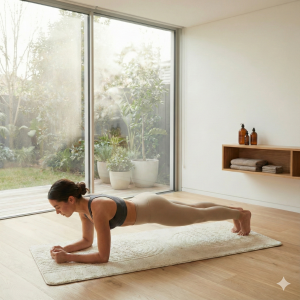The change of season is one of nature’s most magnificent cycles, but for our bodies—and especially our skin and mind—it can be a period of stress. As a practitioner, I often see patients struggling with a silent shift: the transition from summer’s warmth and light to autumn and winter’s cool, dry embrace. This change signals that it’s time for a mindful check-in. Our core needs, both external and internal, change drastically, and relying on summer habits simply won’t suffice.
The key to navigating this transition smoothly isn’t just reacting to problems as they arise, but proactively listening to the subtle signals your body and mind are sending. Think of this process as preventative maintenance for your most valuable asset: you.
The Science Behind the Seasonal Shift
Why do we need to adapt? The answer lies in the environment. As outdoor temperatures drop and winds pick up, the humidity level plummets. Indoors, central heating further strips the air of moisture. This combination acts like a sponge, pulling water directly from your skin’s outer layer—the skin barrier.
For your inner state, less sunlight means less production of Vitamin D and a potential shift in your circadian rhythm. This often results in a dip in energy, focus, and mood, sometimes referred to as the ‘wintering’ instinct. The challenge is that these changes are gradual, which is why a dedicated Mindful Check-in is essential.
Outer Care: Honoring Your Skin Barrier
The single most actionable insight for cooler days is focusing on barrier repair and maintenance. Your skin barrier is your first line of defense against environmental damage and moisture loss. When it’s compromised, you experience dryness, sensitivity, redness, and accelerated aging.
Actionable Skincare Tips:
- Swap to Ceramides and Occlusives: Ditch the light, gel-based lotions you used in August. Cooler weather demands a richer, thicker formulation. Look for creams containing ceramides, which are lipids naturally found in the skin that help hold cells together. Also, seek out occlusive ingredients like shea butter, petrolatum, or dimethicone. These form a physical layer on the skin to lock moisture in.
- Anecdote: I had a client, Sarah, who used the same lightweight hyaluronic acid serum and cream year-round. Every November, she’d experience unexplained facial redness and stinging. We shifted her routine to a ceramide-rich balm at night, and within two weeks, the sensitivity vanished. Her skin simply needed a protective seal, not just another dose of hydration.
- Double Down on Hydration Boosters: While occlusives lock moisture in, you still need to ensure your skin is hydrated. Apply hydration boosters like Hyaluronic Acid (HA) immediately after cleansing, while your skin is still damp. Follow this immediately with your rich moisturizer to trap the HA.
- Mindfully Reduce Harsh Actives: Your skin barrier is more fragile in the cold. It’s wise to pull back on highly concentrated exfoliating actives (like aggressive AHA/BHA peels or strong retinoid treatments) to perhaps 2-3 times per week, rather than nightly. If your skin feels tight or stings, take a break entirely.
Inner Care: Protecting Your Emotional Reserves
The physical and psychological well-being of our inner self is just as susceptible to the seasonal shift. The lower light levels and the tendency to retreat indoors can inadvertently lead to social isolation and a dip in mood.
Actionable Emotional Health Tips:
- Enforce ‘Quiet Time’ Boundaries: As calendars fill up before the holidays, it’s easy to sacrifice down time. Introduce a concept I call ‘Sacred Quiet Time’: a non-negotiable 20-30 minute window, daily, dedicated solely to rest. This isn’t screen time; it’s reading, listening to music, meditating, or simply sitting in stillness.
- Prioritize Movement, Not Just Exercise: You don’t need a grueling gym session to boost mood. The goal is to break the inertia of staying indoors. Even a brisk 15-minute walk outside during the brightest part of the day can help regulate your circadian rhythm and provide a micro-dose of mood-boosting light.
- Case Study: A young professional patient, David, found his productivity plummeting every winter. His problem wasn’t work ethic; it was light deprivation and social isolation. We prescribed a routine where he took a meeting outside (walking with his phone) every day at 1 PM. It wasn’t a treatment, but a re-engagement with the world, and his anxiety significantly reduced.
The Ultimate Tool: Your Body and Mind Scan
To truly tailor your routine, you must first know where the deficit lies. Is it dry skin, or is it emotional fatigue? The Body and Mind Scan is a simple mindfulness tool to pinpoint your needs.
Guided Scan Meditation (Actionable Tool)
Find a quiet spot. Close your eyes.
- Anchor (1 minute): Focus on your breath. Notice the cool air entering your nostrils and the warm air leaving.
- The Body Check: Slowly bring your attention down your body. Notice your forehead, jaw, neck, and shoulders. Are they tense? Feel your hands. Are they dry, or are your knuckles tight? Move to your legs and feet. Identify any tension or physical discomfort.
- The Mind Check: Now, gently ask your inner self: What kind of rest do I need? Is your mind racing (needing quiet time)? Is your body heavy (needing sleep or movement)? Are you feeling lonely (needing connection)?
- The Diagnosis: The first, honest answer is usually the right one. If your skin is yelling ‘dry!’, apply that heavy cream. If your mind is screaming ‘stop!’, schedule that Sacred Quiet Time.
Your goal is to become an expert in your own unique signals. This mindful check-in transforms your care routine from a mindless habit into a personalized, therapeutic practice, ensuring your outer skin and inner soul are both nurtured and resilient for the cooler days ahead.




